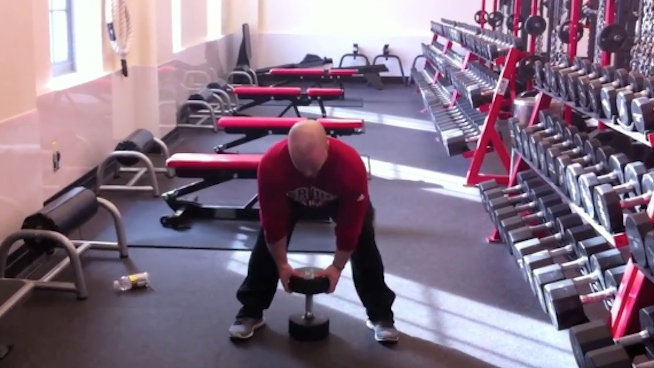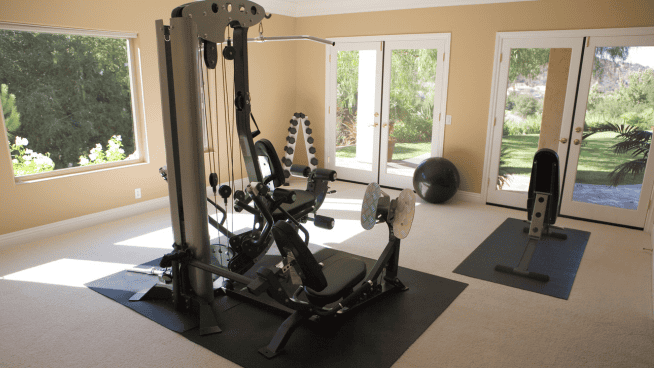Master the Hip Hinge, Exercise’s Most Important Motion
Whoever said, “It’s all in the hips” was right. Hip extension is the most powerful movement in sports, responsible for sprints, jumps, throws, tackles and countless other displays of brute athleticism. Most strength and conditioning programs train hip extension with Cleans, Snatches, Deadlifts and Kettlebell Swings. This is great, because the stronger you get in these movements, the more powerfully you will perform on the field.
But there’s one problem. Many athletes struggle to perform the Hip Hinge exercise, a “bowing” motion that loads up the glutes and hamstrings. If you can’t hinge at the hips before transferring to hip extension, you’ll lose precious power. Here are three drills to master the Hip Hinge, leading to stronger lifts, faster sprints and higher jumps.
Seated Good Morning
[youtube video=”-Upn5rJhu34″ /]Many athletes confuse the Hip Hinge with a Squat. Rather than moving their hips back while keeping their knees stationary, they bend too much at the knees and keep their torso too vertical. This limits the stretch reflex of the glutes and hamstrings, reducing their contribution to hip extension. The Seated Good Morning teaches athletes to hip hinge while keeping their knees still.
- Hold a PVC pipe across your traps like during a Back Squat.
- Sit back onto a box or bench so your hips are above your knees, your shins are vertical and your feet are in front of your hips.
- Place your feet wider than your hips with your toes pointed slightly outward.
- Pull your chest up, shoulders back, chin down and abs tight.
- Keeping a slight arch in your back, bend at the waist until your torso forms a 45-degree angle with your hips, or until you can’t keep your lower back from rounding.
- Push your heels into the floor and return to the starting position.
Some powerlifters use heavy Seated Good Mornings to beef up their hips and lower back, but we are using them to teach you how to move through your hips without moving your knees.
3-Point Hip Hinge
[youtube video=”cGXag6VbeRM” /]The next step is to drill the Hip Hinge exercise in a standing position with the 3-Point Hip Hinge. Using a PVC pipe as your guide, you’ll get instant feedback on correct form.
- Grab a PVC pipe and hold it vertically behind your back with one hand behind your head and the other behind your lower back.
- Hold the PVC pipe in a straight line, touching the back of your head, your upper back and the top of your glutes.
- Stand with your feet hip-width apart and your knees slightly bent.
- Tighten your abs and glutes and make a double chin.
- Slowly push your hips back and lower your chest toward the floor, making sure the PVC pipe stays in contact with the back of your head, mid-back and upper glutes.
- Lower yourself until your torso is near-parallel to the floor or until you can’t keep your back straight.
- Reverse directions by driving your hips forward and flexing your glutes.
Common errors like squatting or rounding your back will make the PVC pipe lose contact with one of the three points. This immediately lets you know whether you’re doing it right or wrong.
Dumbbell Sumo Deadlift
[youtube video=”ZRo8HfvJPgk” /]The final step is to drill the Hip Hinge with added weight. The Dumbbell Sumo Deadlift uses the same Hip Hinge mechanics as the first two exercises, but forces you to stay tight and forcefully extend your hips under load.
- Stand a dumbbell on its end on the floor.
- Stand over and slightly in front of the dumbbell so that you can’t see it if you look straight down.
- Place your feet slightly outside hip-width with your knees slightly bent.
- Get your chest up, shoulders back, and abs tight and make a double chin.
- Without bending your knees further, push your hips back and lower your chest toward the floor.
- Reach for the dumbbell, keeping your back straight and bending your knees a little more if you need to.
- Once you can grab the dumbbell, pick it up and reverse directions by pushing your hips forward and squeezing your glutes.
- Return the dumbbell to the floor by hinging at the hips like the first rep.
The Dumbbell Sumo Deadlift can be used as a light warm-up to drill the Hip Hinge or as a heavy lower body exercise. If done correctly, it’s a solid alternative to straight bar Deadlifts.
Sample Warm-up
These drills fit nicely into a lower-body warm-up to get ready for some heavy Cleans or Deadlifts. Try this sample warm-up and prime yourself to get powerful.
- Foam Roll (upper back, glutes, hamstrings) – x 10-20 passes each
- Dead Bugs – x 5 per side
- Seated Good Morning – x 15
- Walking Lunges – x 8 per side
- 3-Point Hip Hinge – x 15
- Lateral Lunge with Overhead Reach – x 8 per side
- Dumbbell Sumo Deadlift – x 8
Read More:
[cf]skyword_tracking_tag[/cf]RECOMMENDED FOR YOU
MOST POPULAR
Master the Hip Hinge, Exercise’s Most Important Motion
Whoever said, “It’s all in the hips” was right. Hip extension is the most powerful movement in sports, responsible for sprints, jumps, throws, tackles and countless other displays of brute athleticism. Most strength and conditioning programs train hip extension with Cleans, Snatches, Deadlifts and Kettlebell Swings. This is great, because the stronger you get in these movements, the more powerfully you will perform on the field.
But there’s one problem. Many athletes struggle to perform the Hip Hinge exercise, a “bowing” motion that loads up the glutes and hamstrings. If you can’t hinge at the hips before transferring to hip extension, you’ll lose precious power. Here are three drills to master the Hip Hinge, leading to stronger lifts, faster sprints and higher jumps.
Seated Good Morning
[youtube video=”-Upn5rJhu34″ /]Many athletes confuse the Hip Hinge with a Squat. Rather than moving their hips back while keeping their knees stationary, they bend too much at the knees and keep their torso too vertical. This limits the stretch reflex of the glutes and hamstrings, reducing their contribution to hip extension. The Seated Good Morning teaches athletes to hip hinge while keeping their knees still.
- Hold a PVC pipe across your traps like during a Back Squat.
- Sit back onto a box or bench so your hips are above your knees, your shins are vertical and your feet are in front of your hips.
- Place your feet wider than your hips with your toes pointed slightly outward.
- Pull your chest up, shoulders back, chin down and abs tight.
- Keeping a slight arch in your back, bend at the waist until your torso forms a 45-degree angle with your hips, or until you can’t keep your lower back from rounding.
- Push your heels into the floor and return to the starting position.
Some powerlifters use heavy Seated Good Mornings to beef up their hips and lower back, but we are using them to teach you how to move through your hips without moving your knees.
3-Point Hip Hinge
[youtube video=”cGXag6VbeRM” /]The next step is to drill the Hip Hinge exercise in a standing position with the 3-Point Hip Hinge. Using a PVC pipe as your guide, you’ll get instant feedback on correct form.
- Grab a PVC pipe and hold it vertically behind your back with one hand behind your head and the other behind your lower back.
- Hold the PVC pipe in a straight line, touching the back of your head, your upper back and the top of your glutes.
- Stand with your feet hip-width apart and your knees slightly bent.
- Tighten your abs and glutes and make a double chin.
- Slowly push your hips back and lower your chest toward the floor, making sure the PVC pipe stays in contact with the back of your head, mid-back and upper glutes.
- Lower yourself until your torso is near-parallel to the floor or until you can’t keep your back straight.
- Reverse directions by driving your hips forward and flexing your glutes.
Common errors like squatting or rounding your back will make the PVC pipe lose contact with one of the three points. This immediately lets you know whether you’re doing it right or wrong.
Dumbbell Sumo Deadlift
[youtube video=”ZRo8HfvJPgk” /]The final step is to drill the Hip Hinge with added weight. The Dumbbell Sumo Deadlift uses the same Hip Hinge mechanics as the first two exercises, but forces you to stay tight and forcefully extend your hips under load.
- Stand a dumbbell on its end on the floor.
- Stand over and slightly in front of the dumbbell so that you can’t see it if you look straight down.
- Place your feet slightly outside hip-width with your knees slightly bent.
- Get your chest up, shoulders back, and abs tight and make a double chin.
- Without bending your knees further, push your hips back and lower your chest toward the floor.
- Reach for the dumbbell, keeping your back straight and bending your knees a little more if you need to.
- Once you can grab the dumbbell, pick it up and reverse directions by pushing your hips forward and squeezing your glutes.
- Return the dumbbell to the floor by hinging at the hips like the first rep.
The Dumbbell Sumo Deadlift can be used as a light warm-up to drill the Hip Hinge or as a heavy lower body exercise. If done correctly, it’s a solid alternative to straight bar Deadlifts.
Sample Warm-up
These drills fit nicely into a lower-body warm-up to get ready for some heavy Cleans or Deadlifts. Try this sample warm-up and prime yourself to get powerful.
- Foam Roll (upper back, glutes, hamstrings) – x 10-20 passes each
- Dead Bugs – x 5 per side
- Seated Good Morning – x 15
- Walking Lunges – x 8 per side
- 3-Point Hip Hinge – x 15
- Lateral Lunge with Overhead Reach – x 8 per side
- Dumbbell Sumo Deadlift – x 8
Read More:











